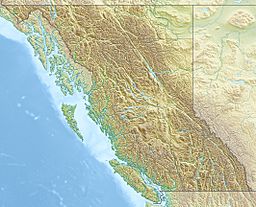Dieppe Mountain facts for kids
Quick facts for kids Dieppe Mountain |
|
|---|---|
| Highest point | |
| Elevation | 2,863 m (9,393 ft) |
| Prominence | 1,058 m (3,471 ft) |
| Parent peak | Tuchodi Peak |
| Geography | |
| Parent range | Northern Rocky Mountains |
Dieppe Mountain is a tall peak located in British Columbia, Canada. It stands at an impressive height of 2,863 meters (about 9,393 feet). This makes it one of the higher mountains in the area.
The mountain rises 1,058 meters (about 3,471 feet) above Gataga Pass. This measurement is called its prominence. It shows how much a mountain stands out from the land around it. Dieppe Mountain is part of the Northern Rocky Mountains.
Exploring Dieppe Mountain
Dieppe Mountain is a significant part of the Northern Rocky Mountains. This large mountain range stretches across western North America. It is known for its rugged beauty and vast wilderness.
The closest major peak to Dieppe Mountain is Tuchodi Peak. Tuchodi Peak is about 55 kilometers (34 miles) away. Think of Tuchodi Peak as a "parent peak" because it is taller and more dominant.
The Battle of Britain Range
Dieppe Mountain is part of a special group of mountains called the Battle of Britain Range. This range is unique because its peaks are named to remember important events and people from World War II. World War II was a very big global conflict that happened from 1939 to 1945. Many countries were involved in this war.
The names of these mountains honor the leaders of the Allied forces. They also mark places where these leaders met for important discussions. Some names also remember battles where Canadian soldiers bravely fought.
For example, you can find peaks like Mount Churchill. This mountain is named after Winston Churchill, a famous leader from the United Kingdom. There's also Mount Roosevelt, named after Franklin D. Roosevelt, a leader from the United States.
Other mountains in this range include Teheran Mountain and Yalta Peak. These names recall cities where important meetings took place during the war. Peaks like Falaise Mountain and Ortona Mountain are named after battles. These battles were significant moments where Canadian troops played a key role.
This naming tradition helps us remember important historical events. It also honors the people who were part of them.


